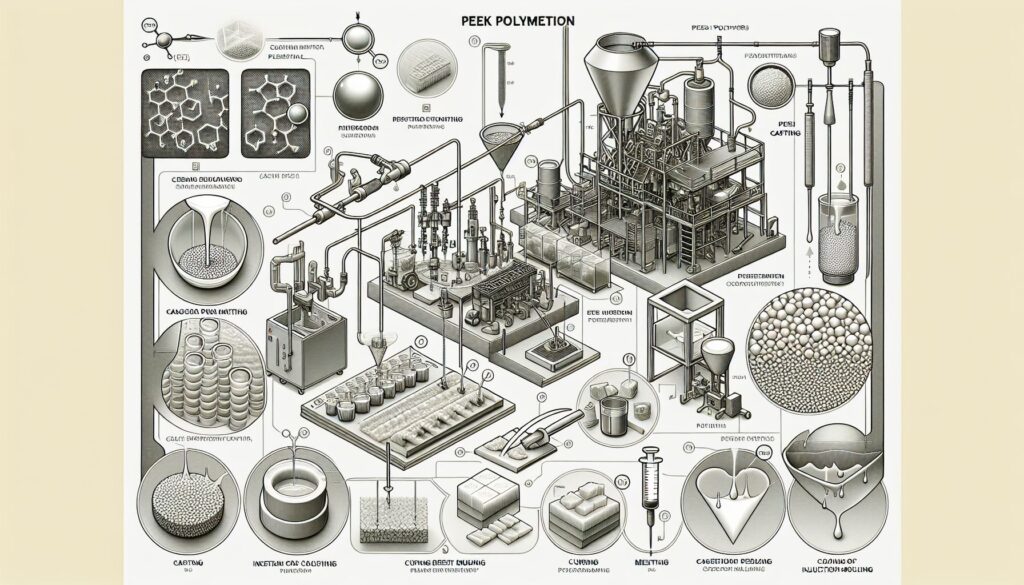In the world of advanced polymers, one material that stands out for its exceptional properties and versatility is PEEK. Polyether ether ketone (PEEK) is a high-performance thermoplastic polymer that has revolutionized various industries due to its unique combination of mechanical, thermal, and chemical properties. PEEK has found its way into countless products and technologies, from aerospace to medical applications. This article will delve deep into the world of PEEK advanced polymer, exploring its characteristics, applications, and the fascinating process behind its polymerization.

What is PEEK?
PEEK is a semi-crystalline thermoplastic belonging to the polyaryletherketones family (PAEK). It was first developed in 1978 by Victrex plc., a leading manufacturer of high-performance polymers. The molecular structure of PEEK consists of repeating units containing an aromatic ketone group connected by ether linkages. This unique structure gives rise to remarkable properties that set it apart from other polymers.
Key Characteristics of PEEK
- High-Temperature Resistance: One of the most impressive features of PEEK is its ability to withstand extreme temperatures without losing its mechanical integrity. It can operate continuously at temperatures up to 250°C (482°F) with short-term excursions up to 300°C (572°F), making it suitable for demanding applications where conventional plastics would fail.
- Excellent Chemical Resistance: Another notable property of PEEK is its resistance to various chemicals, including acids, bases, solvents, oils, and greases. This makes it an ideal choice for environments where exposure to corrosive substances is expected.
- Mechanical Strength: Despite being lightweight compared to metals, PEEK exhibits exceptional mechanical strength and rigidity. It has a high tensile strength and modulus of elasticity, making it suitable for load-bearing applications.
- Low Friction Coefficient: PEEK has a low friction coefficient, similar to PTFE (polytetrafluoroethylene). This property makes it an excellent choice for applications requiring reduced wear and friction, such as bearings and seals.
- Biocompatibility: PEEK is biologically inert and does not elicit adverse reactions when in contact with human tissues or bodily fluids. This biocompatibility makes it ideal for medical implants and devices.
The Polymerization Process
The synthesis of PEEK involves a two-step process: nucleophilic substitution reaction followed by polycondensation. Let’s explore each step in detail:
Nucleophilic Substitution Reaction
In the first step, 4,4’-difluorobenzophenone (DFBPA) reacts with bisphenol-A (BPA) in the presence of an alkali metal base catalyst such as potassium carbonate (K2CO3). This reaction leads to the intermediate diphenyl ether ketone (DPEK) formation.
Chemical Equation:
DFBPA + 2 BPA + 2 K2CO3 → DPEK + 4 KF + CO2
Polycondensation
The second step involves the polycondensation reaction, where DPEK undergoes further polymerization to form long chains of PEEK. This process is typically carried out under high temperatures (>300°C) and vacuum conditions to facilitate the removal of volatile by-products.
Chemical Equation:
n DPEK → [PEEK]n + n phenol
It is important to note that water molecules are generated as a by-product during this process, which can hinder molecular weight development if it is not removed effectively.
Applications of PEEK
Due to its exceptional properties, PEEK has found widespread use in various industries. Let’s explore some of its critical applications:
Aerospace and Defense
PEEK is widely used in aerospace and defense due to its lightweight nature, high strength, and chemical resistance. It is used in components such as brackets, connectors, seals, and electrical insulation.
Oil and Gas
The oil and gas industry relies on materials that can withstand harsh environments. PEEK’s chemical resistance and high-temperature stability suit it for downhole applications like seals, bushings, valves, and pump components.
Medical Devices
PEEK is extensively used in the medical field due to its biocompatibility and sterilizability. It finds applications in orthopedic implants (such as spinal cages), surgical instruments, dental tools, and prosthetics.
Automotive
Due to its flame-retardant properties, in the automotive industry, PEEK is utilized for various purposes, including electrical connectors, fuel system components (such as sensors), gears, bearings, bushings, and interior trims.
Electronics
PEEK’s excellent dielectric properties make it a preferred choice for electrical insulation applications such as connectors and insulating tapes. Its ability to withstand high temperatures makes it suitable for electronic device housings.
PEEK advanced polymer has proven to be a game-changer in various industries due to its exceptional properties and versatility. From aerospace to medical applications, its ability to withstand high temperatures, resist chemicals, and maintain mechanical strength makes it an ideal choice for demanding environments. The polymerization process behind the creation of PEEK involves nucleophilic substitution reactions followed by polycondensation. With its wide range of applications and continuous advancements in manufacturing techniques like 3D printing, the future looks bright for this remarkable material.
Frequently Asked Questions (FAQs)
- Is PEEK recyclable?
Yes! PEEK can be recycled through methods like pyrolysis or mechanical recycling processes. - What are the limitations of using PEEK?
While highly versatile, there are a few limitations to using PEEK. It comes at a higher cost compared to conventional plastics. Additionally, machining or processing it can be challenging due to its high melting point. - Can PEEK be 3D printed?
Yes! With technological advancements, especially selective laser sintering (SLS) and fused deposition modeling (FDM), PEEK can be successfully 3D printed. - Is PEEK FDA-approved for medical applications?
PEEK has received FDA approval for various medical applications, including orthopedic implants and surgical instruments. - What are the advantages of using PEEK over metals?
Using PEEK instead of metals offers several advantages, such as weight reduction, corrosion resistance, electrical insulation properties, and easier processing and machining.
